One of the worst feelings for me is that of being powerless…of seeing a critical need before me and having no way to help. I can’t imagine how it felt for the firefighters, neighbors, family members, and others who were forced to watch last week’s senior home fire in Quebec, without any way to rescue most of the residents – some of whom could be seen or heard until they were taken by the smoke and flames. Heartbreaking stories are emerging, including one of a man who was able to reach his mother on her balcony and wrap her in warm clothing or blankets, but could not rescue her. The fire in L’Isle-Verte is believed to have killed 32 of the home’s elderly residents, although recovery of the victims is extremely slow because the remnants of the building are encased in ice.
But we are not powerless. We can turn tragedy into action. It’s unfortunate that it so often takes a fatal fire to prompt changes to codes and laws, but historically this has been the case. If we study each incident, learn, and improve, there is hope that the lives will have not been lost in vain, and that future tragedies may be avoided. Code development and legislative changes take time, often several years, but we can’t allow that to deter us from working toward improved life safety.
The cause of this fire is not yet known, but the news media is already reporting on theories and possible contributing factors. An article from La Presse, shared by Maxime Drouin discusses the efforts and limitations of fire prevention inspectors. One focus area is sprinkler systems, which are required by current codes for certain occupancy types. Many existing buildings were not required to have sprinklers when they were built and have not been retrofitted with sprinkler systems, usually due to the associated cost. If sprinklers are not required by code / law, building owners can not be forced to install them.
The article mentions an issue found during many of the periodic inspections of senior homes – fire doors that are propped open. Because fire doors are required to be self-closing to compartmentalize the building and deter the spread of smoke and flames, they can be difficult for elderly people to open. There is not yet any evidence that open fire doors played a part in the L’Isle Verte fire, but if it is a problem frequently encountered by fire inspectors, it must be addressed more vigorously than in the past.
In 2004, a fire occurred at the Rosepark Care Home, in Uddington Scotland, and fourteen of the home’s residents were killed. Due to the preferences of residents, some door closers had been disabled and other doors were propped open with wedges. A fatal accident inquiry determined that in addition to other factors, the open position of the residents’ bedroom doors during the fire contributed to the outcome: From the report: “The bedroom doors, if they had all been closed, would have withstood the fire in the corridor for a period of time sufficient for the fire to die back from lack of air, so that fire penetration into the bedrooms would not, in the absence of some exceptional circumstances causing flame impingement directly on the door, have occurred.” Although the home was periodically inspected by various authorities, many inspectors did not note the open bedroom doors as an issue.
Adoption and enforcement of the annual fire door inspection requirements, education of staff and residents, fire drills, and hold-open devices which close doors automatically upon actuation of the fire alarm system can help to address this problem and improve safety for senior home residents. Although the widespread indifference and lack of understanding may seem insurmountable, we can’t give up. When you see an opportunity to educate and enlighten, take it.
Some additional news articles on the fire in L’Isle Verte:
Quebec fire was ‘Night from Hell’ – BBC News
Nursing home fire echoes Norfolk’s tragic past – Simcoe Reformer
Nursing home fires have a long history in Canada.
Despite improvements to building codes and the tightening of fire regulations, Canadians are confronted every few years with the horror of a deadly fire at a seniors home.
Thursday’s fire in L’Isle-Verte, Quebec, is believed to have claimed at least 30 lives. Horrific, to be sure, but by no means the worst.
A fire in a seniors home in Notre-Dame-du-Lac, Quebec, claimed 54 lives in 1969. Twenty-one died and 35 were injured in a nursing home fire in Mississauga in 1980. Twenty-two died in a fire in Goulds, Newfoundland, in 1976, including a 105-year-old woman.
L’Isle-Verte Fire Survivors Describe Narrow Escape – The Huffington Post Canada
Other incredible stories of survival have emerged in L’Isle-Verte as more family members arrive at the scene to support their mothers, fathers, aunts and uncles who escaped the blaze.
Marie-Luce Dionne drove from Campbellton, N.B., to help her mother, who was also living in the newer wing of the Résidence du Havre. The flames were cut down by a firewall between the two sections. The newer portion is still standing. The older portion of the building is completely unrecognizable.
“I told my mom there were angels that night for her because she used to be in the apartment 206 [in the old section], apparently where the fire started,” Dionne said.
“She was moved down in the new [wing] on Dec. 27. There was a reason for that. She was saved maybe because she was moved there.”
Quebec elderly home fire: ‘The heart of our village is now gone’ – CNN World
At least 37 of the residents were older than 85, according to government documents obtained by CBC.
Many of them had Alzheimer’s disease and used wheelchairs or walkers, acting Mayor Ginette Caron told CBC.
Nelida Pettigrew, 90, told CBC she left her walker behind, escaping down two flights of stairs to safety after a neighbor pointer her toward the emergency exit. But others didn’t make it.
Quebec won’t rush on sprinkler law after deadly seniors-home fire – The Globe and Mail
The incident has raised questions about whether the provincial requirements concerning fire safety – and the use of sprinklers in particular – and night supervision are adequate.
Ms. Marois said that while the clamour to act swiftly is understandable, her government will wait until a working group commissioned to consider the matter a year ago reports back.
“If they recommend to us to change the rules, to change the law to implement sprinklers, we will do that, and we will adopt the rules,” she said.
‘We can get through this’: Grieving town stands by owner of fire-ravaged Quebec seniors home – National Post
Since fire swept through the residence, questions have been raised about whether there was an adequate sprinkler system in place. There has also been speculation that one resident in his 90s, known to be a heavy smoker, might have lit up in his room after being told not to go out in the cold. The man died in the fire.
But on Sunday, the focus was on coming together to begin mourning the lives lost. “We are all gathered in the same sorrow, in a profound suffering that breaks the heart,” parish priest Gilles Frigon said, praying that “we can, all together, recover our strength and courage.”
Video: L’Isle-Verte a ‘terrible tragedy’, Pauline Marois says – Montreal Gazette
Only the new part of the Résidence du Havre had sprinklers. The older part of the building is what collapsed, killing residents. Yet the building conformed to the current government norms and, in a recent practice fire drill, managed to get everybody out in 10 minutes.
The Regroupement québécois des résidences pour aînés recently recommended that sprinklers be required in all seniors’ residences.
“We will take every step possible to ensure this doesn’t happen again,” Marois said.
UPDATE: I just saw this one and thought I should add it…
Stop the nonsense. Require sprinklers in all nursing homes. – The Globe and Mail
In a new building, besides sprinklers, fire retardant building materials must be used, concrete preferred over wood, and pressed wood is not allowed. The door to every resident room is a fire door – shut the door and neither smoke nor fire can get through. There must be fire zones – groups of rooms or common areas of a limited size behind another self-closing fire door. So in a fire, the sprinkler would be activated where the fire starts. Residents can be safe inside their rooms. Staff would move the residents out of the zone where the fire started and into another zone and shut the door. No need to carry people down the back stairs. A few staff can move the residents into the next zone in good time. And they practice at least annually.
You need to login or register to bookmark/favorite this content.





Leave A Comment